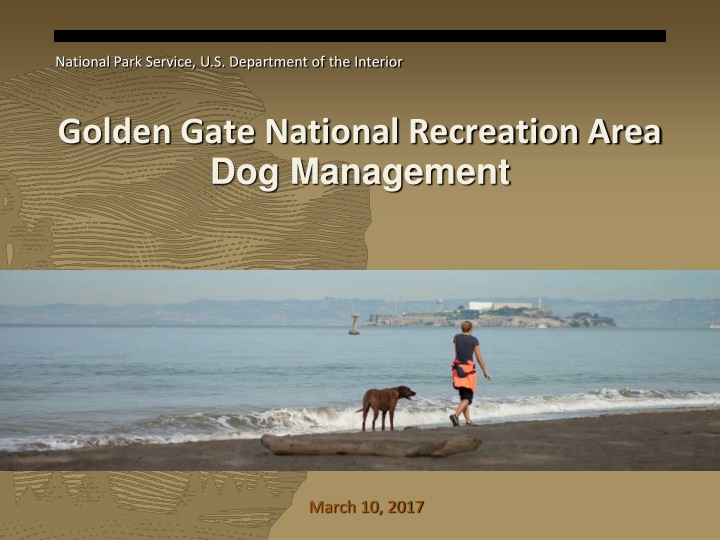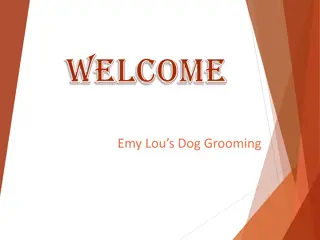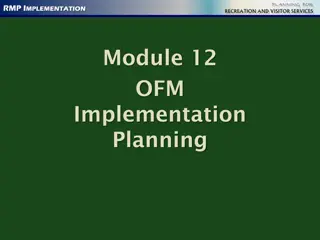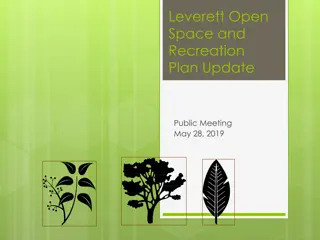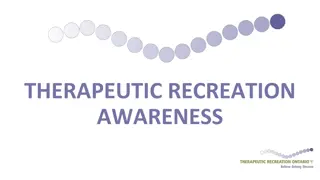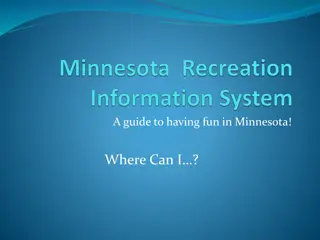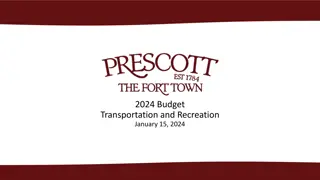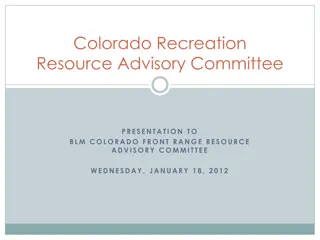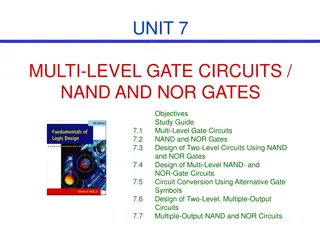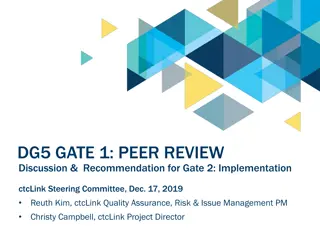Golden Gate National Recreation Area Dog Management Plan
The National Park Service at the Golden Gate National Recreation Area has implemented a comprehensive strategy for dog management. The plan aims to preserve natural and cultural resources, protect habitats, improve visitor safety, and reduce conflicts. Key elements include off-leash restrictions on trails, focusing dog walking in designated areas, and providing various visitor experiences. Legal mandates prioritize resource conservation and appropriateness of park use, ensuring future generations can enjoy the park's beauty.
Uploaded on Feb 17, 2025 | 2 Views
Download Presentation

Please find below an Image/Link to download the presentation.
The content on the website is provided AS IS for your information and personal use only. It may not be sold, licensed, or shared on other websites without obtaining consent from the author.If you encounter any issues during the download, it is possible that the publisher has removed the file from their server.
You are allowed to download the files provided on this website for personal or commercial use, subject to the condition that they are used lawfully. All files are the property of their respective owners.
The content on the website is provided AS IS for your information and personal use only. It may not be sold, licensed, or shared on other websites without obtaining consent from the author.
E N D
Presentation Transcript
National Park Service, U.S. Department of the Interior Golden Gate National Recreation Area Dog Management March 10, 2017
Briefing Objectives Internal Deliberative
Golden Gate National Recreation Area E X P E R I E N C E Y O U R A M E R I C A Internal Deliberative
Golden Gate National Recreation Area E X P E R I E N C E Y O U R A M E R I C A Internal Deliberative
Background 1979 Pet Policy: Continued historic off-leash in key GGNRA areas Contradicts existing NPS Regulation 36 CFR 2.15 Increases in park visitation and visitor conflicts Three lawsuits on closures for resource protection and enforcement (late 1990 s 2005); court order Result: GGNRA must promulgate special regulation to make any changes from the 1979 Pet Policy Process: Negotiated Rulemaking: 2006-2007 Plan and NEPA: DEIS 2011, SEIS 2013, FEIS 2016 Proposed Rule: 2016 E X P E R I E N C E Y O U R A M E R I C A 11
NPS Legal mandates NPS Organic Act Must leave resources unimpaired for future generations NPS Management Policies (Section 1.4 - 1.5) Use must be appropriate No unacceptable impacts or impairment when there is a conflict between conserving resources and values and providing for enjoyment of them, conservation is to be predominant. 11
Objectives of dog management Provide a clear, enforceable dog management policy Preserve and protect natural and cultural resources and natural processes Protect sensitive habitats and preserve areas of contiguous habitat Focus most dog walking in developed or disturbed front country areas, or on periphery of habitat areas Off-leash not on trails Provide a variety of visitor experiences, including dog walking Improve visitor and employee safety Reduce user conflicts E X P E R I E N C E Y O U R A M E R I C A Internal Deliberative
Stakeholder Context Dog groups Environmental groups Elected Officials and Constituents E X P E R I E N C E Y O U R A M E R I C A Internal Deliberative
Dog walking is an appropriate use, when managed Longstanding historic use; a primary user group Source of recreation that brings people to the park Provides for affiliated sense of community; makes some feel safer Can be important park partner in clean-up of areas Park should be available to all appropriate uses; but one type of use should not exclude others 14
E X P E R I E N C E Y O U R A M E R I C A Internal Deliberative
Overview of Preferred Alternative and Rule Designates 22 dog walking locations in GGNRA, as well as places that would be dog-free. Also addresses commercial use. Dog walking would be allowed on: Nearly one-third of the miles of beaches, mostly off-leash One-third of the miles of trails Additional acreage not part of beaches or trails Off-leash dog walking would be allowed in 6 park locations, some with more than one area. Specific areas would be designated for walking 4-6 dogs under permit, Mon-Fri E X P E R I E N C E Y O U R A M E R I C A Internal Deliberative
Dog Walking Access Changes from Current Conditions to Pref d Alt MAJOR BEACHES GGNRA Total Current Use Pref d Alt 8.8 miles 4.5 miles off-leash 2.3 miles off-leash 2.7 miles on-leash 0.5 miles on-leash 7.2 miles (82%) 2.8 miles (32%) TRAILS GGNRA Total Current Use Pref d Alt 140 miles 25 miles off-leash 1 mile off-leash 49 miles on-leash 46 miles on-leash 74 miles (53%) 47 miles (34%) E X P E R I E N C E Y O U R A M E R I C A Internal Deliberative
Fort Funston FEIS Alt F- Preferred SEIS Alt A
Potentially relevant documents for Review Team Planning process overview and timeline EIS Literature review (SEIS) Natural resource overview (SEIS) Visitor use and experience overview (SEIS) Proposed rule Proposed rule public comment and responses (responses are currently draft and internal deliberative but will be part of final rule) FEIS E X P E R I E N C E Y O U R A M E R I C A
Changes to Prefd Alt from DEIS SEIS - FEIS Various changes to multiple areas, primarily expanding areas for dog use both on and off leash (DEIS, SEIS, FEIS) Evaluated additional studies for inclusion as recommended through public comment (SEIS and FEIS) Updated the monitoring program (SEIS and FEIS) Additional analysis of potential redistributive effects (SEIS, FEIS) Improved accessibility (SEIS and FEIS) Added new area Rancho Corral de Tierra to the analysis (SEIS) E X P E R I E N C E Y O U R A M E R I C A
Changes from DEIS to SEIS Review of all studies for peer review Additional analysis of potential redistributive effects, surveying over 7000 people for potential changes in use patterns (both city, county, state, and other GGNRA lands) based on dog restrictions Water quality as an impact topic dismissed Refocus on visitor experience as a primary impact topic. Changes to the compliance-based management strategy (monitoring strategy) Additional Federal Rehabilitation Act elements and analysis Removal of programmatic alternative New Lands and instead a site specific analysis for Rancho Corral de Tierra The majority of the areas addressed in the plan received minor or no changes to the preferred alternative. Larger changes in a few areas: Additional access for dog walking provided at Fort Funston Crissy Field adjustments to off-leash areas Rancho Coral de Tierra (now 36 CFR 2.15 vs. closed-unless opened under New Lands)
Changes from SEIS to Proposed Rule Increased restrictions on walking 4-6 dogs Adjustment of two voice and sight control areas (Crissy Airfield and upper Fort Funston) Addition of four, on-leash trail segments in San Mateo Changed on-leash segment to dog free at Ft. Baker Defined uncontrolled and unattended dogs Created on-leash and no dog picnic areas Additional considerations for monitoring and management program
Changes from Proposed Rule to FEIS Based on a limited review, the changes to the FEIS preferred alternative that could have been affected by public comment on the proposed rule related to HL emails are instead generally pro-dog (see below): Addition of an on-leash loop trail at Muir Beach on Kaashi Way. Addition of a 3 acre voice and sight control area in Rancho Corral de Tierra Addition of an accessible on and off-leash trail at Fort Funston Expansion of voice and sight control and dog free areas on Crissy Airfield (slight adjustment only here) Realignment and Expansion of on-leash area on Baker Beach Addition of on-leash trail at Mori Point Addition of on-leash trail to overlook at Milagra Ridge Designation of both dog free and dog friendly picnic areas
Questions E X P E R I E N C E Y O U R A M E R I C A Internal Deliberative
